Mid Range Graphics Card CPU scaling
For mid-range cards we've got three from ATI and one from NVIDIA; as we've discovered in previous Half Life 2 articles, NVIDIA's last-generation mid-range cards are only reasonable performers in DirectX 8 mode, and we are conducting a fully DX9 comparison here so that excludes all of them. From ATI we've got the Radeon 9700 Pro, Radeon 9800 Pro and Radeon X700 Pro. We've also included the NVIDIA GeForce 6600GT, which as you will remember from our previous articles, performs very similarly to the GeForce 6800 non-ultra under Half Life 2.
Our mid-range tests were conducted at 1280 x 1024, the target resolution for most mid-range cards.

If you've got any of ATI's mid-range GPUs, you're stuck with severely diminishing returns after about 1.4 - 1.6GHz on the Athlon 64 (< 2800+ range). The GeForce 6600GT is far less GPU bound at 1280 x 1024 (and even at 1024 x 768 although not depicted here), and thus scales relatively well.
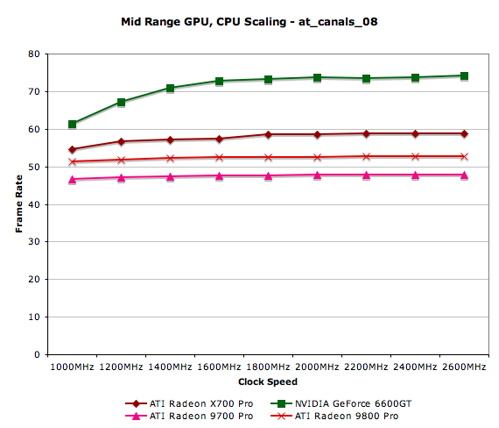
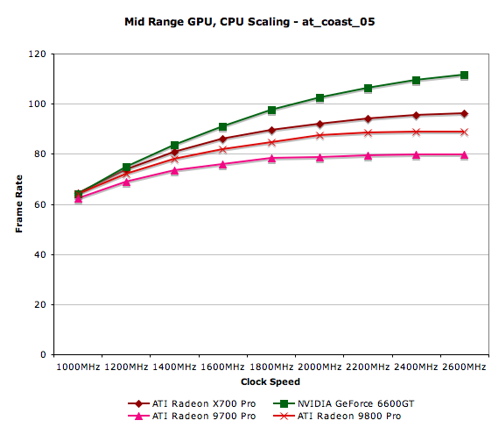
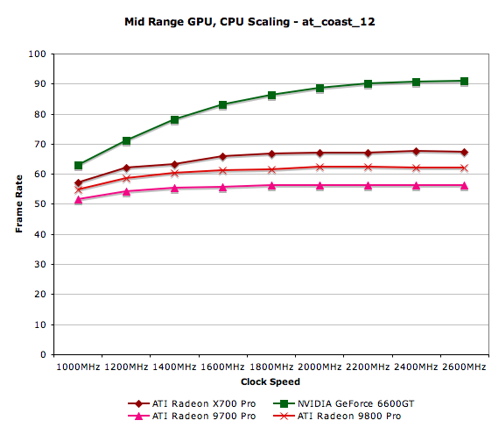
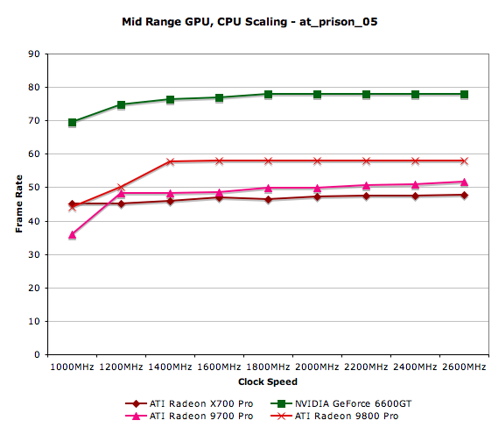
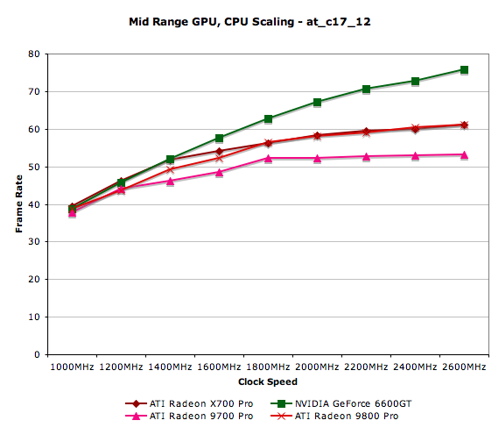
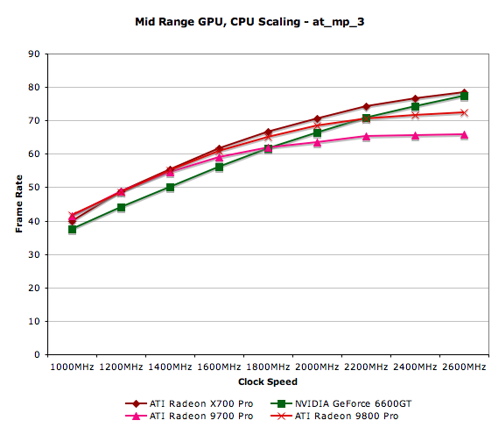










68 Comments
View All Comments
Roooooooooooooooooot - Wednesday, January 26, 2005 - link
Ommmmm ... yes, a very nice article :)
More than any article I've seen, this one made the point about the power of AMD processors for 3D gaming.
"Megahertz Shmegahertz" could have been the title. The 3.8 Pentium running neck and neck with a 2 GHz AMD CPU. Now I understand !!
One place I worked had hundreds of Dell Workstations. They gave us dual xeon ultra-SCSI jobbies. It may not sound like much, but 2 1 GHz Xeon's with an 18 Gig U160 or was it 320 SCSI HDD and an ATI FireGL graphics card was what I had.
I would love to see an article about corporate CAD machines, AMD vs. Intel with various scales of video cards.
bamacre - Wednesday, January 26, 2005 - link
1,000,001 demands for A XP benchies, how about one for high-end Northwood P4's ?? Please?AkumaX - Wednesday, January 26, 2005 - link
I one MEELIONTH the motion, i wish there were a XP barton benchmark somewhere in there, not just w/ the XP3200 (2.2ghz) but also w/ 2.3ghz and 2.4ghz (since most of us appear to also be running o/ced mobiles :P)michael2k - Wednesday, January 26, 2005 - link
What did you expect? People were demanding the HL2 CPU article in the Mac threads... and lo and behold, the next day, Anand has posted the HL2 CPU article.You can either get something now, or you can get something finished... very rarely can you get both :)
Crassus - Wednesday, January 26, 2005 - link
I was also quite surprised that the article still appeared. I'm glad it did, but I think it falls short of Anandtechs high standard:1. For comparison, at least two AXP (two to see how it scales) should be in the test field
2. As previously mentioned, Processor/speed/cache/socket. There is more that just one Athlon 64 3000+
3. Including CAS 2,5 would have been nice as this seems to be the default for people using mainstream DDR3200 RAM
4. What's the deal with the Athlon 3500+ in diagramm 3 on page 2?
Something else bothered me:
Quote: "If you are stuck with one of those older but still well-performing GPUs, don't bother upgrading your CPU unless it's something slower than a 2.4GHz Pentium 4 - you'd be much better served by waiting and upgrading to dual core later on."
Common wisdom seemed to be that especially games don't take advantage of multi-threading. Do you have any new information that upcoming games are geared more towards multiple CPUs/cores/HT?
quanta - Wednesday, January 26, 2005 - link
The test didn't show the impact of using partial precision vs full precision on NVIDIA cards. As some people have mentioned[1], Half-Life 2 doesn't need full 32-bit precision to run smoothly. In effect, NVIDIA card is running in speed crippled by the game's designers.[1] http://3dgpu.com/archives/2004/12/01/boost-perform...
DavidHull - Wednesday, January 26, 2005 - link
I second the need for SLI configurations to be included, as many reviewers have found them to be extremely limited by the CPU.AtaStrumf - Wednesday, January 26, 2005 - link
Interactive 3D charts in flash. Khm,... can it be done?AtaStrumf - Wednesday, January 26, 2005 - link
I was starting to think this article has been bined, but fortunately it wasn't.First of all I agree with the need for an AXP 3200+ in the charts. It's still a very, very common PCU!
Secondly this is only an OK article by Anand's standards. The first thing that really bothered me was how the CPU's are marked by some very long but also very useless names, like
AMD Athlon 64 3400+ (2.4 GHz)
Intel Pentium 4 570 (3.8 GHz)
This takes a lot of room on the carts but still tells me nothing about Cache size or Socket type. I suggest names like:
A64 3400+/S754/512kB/2.4GHz (its shorter and says a lot more)
Same thing for Intel: P4 570/Socket/Cache...
And how in the hell did you come up with CAS3? Most DDR 400 RAM (excluding OEMs) is CAS 2,5 and not 3 or 2. I appreciate the memory tests very much though, I just regret the very basic mistake in the underlaying assumptions.
I understand it was a low priority, seriously delayed article, but I just can't shake the feeling it could have been so much more.
One of these days I'm gonna have to take some time and put together a demo of how data is properly presented.
Questar - Wednesday, January 26, 2005 - link
"Next let’s take a look at at_coast_05, another very GPU limited test that has a good deal of NPC interaction as well as GPU limiting elements:"
How the hell could this be GPU limited if the difference from top to bottom of the graph is > 50%?